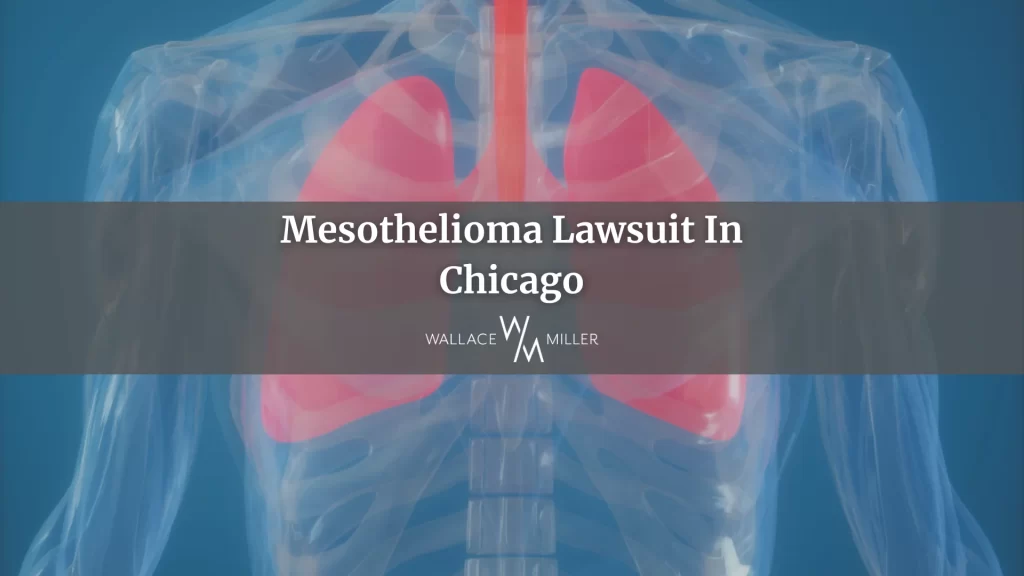
Learn More About How Asbestos Litigation Impacts You
Wallace Miller is currently investigating legal claims as a result of exposure to asbestos.
Asbestos was once one of the most commonly used industrial materials. Its resistance to the elements made it an effective insulator, and manufacturers found uses for the mineral substance in hundreds of different industries. However, asbestos is highly toxic and has been linked to numerous forms of cancer including mesothelioma, adenocarcinoma, ovarian cancer, and lung cancer.
Despite what we know today about asbestos, it is still the #1 cause of work-related deaths in the world. Between 12,000 and 15,000 Americans die from diseases related to asbestos each year, often decades after being exposed.
If you or a loved one have been harmed due to asbestos exposure, contact Wallace Miller today to learn more about filing a mesothelioma lawsuit. We can be reached at 312-261-6193 or via our online questionnaire for a free and confidential consultation.
What is asbestos?
Asbestos is a flexible material commonly used in building materials due to its resistance to electricity, heat, and corrosion. A naturally occurring mineral found in rock and soil, it is made up of silicon, oxygen, hydrogen, and other metal ions. There are several forms of asbestos, including chrysolite, amosite, and crocidolite.

A stereograph of men working in the mine collecting asbestos, Quebec, Canada. Photograph courtesy of the Library of Congress.
Asbestos has been shown to be highly toxic to humans, causing cancer, lung disease, and other serious health effects. While regulatory and legislative efforts have limited its use over the last 50 years, it can still be found in some materials sold in the U.S.
Because asbestos fibers are extremely small, the mineral is mixed with other materials for commercial purposes. These asbestos-containing building materials (ACBMs) have been used across industries for many commercial and manufacturing purposes. These include insulation of walls, ceilings, and beams; plumbing, heating, and HVAC; fire retardant materials and fabrics; and automotive applications including packaging, coatings, and gaskets. The use of asbestos was once so common that every building constructed before the 1980s is assumed to contain asbestos in some form.
Asbestos was once mined throughout North America. However, it is now primarily mined in China, Kazakhstan, and Russia.
How are people exposed to asbestos?
Asbestos only becomes an issue when asbestos-containing materials deteriorate. As ACBMs degrade over time, they release needle-like fibers that are too small to detect with the human eye. These can then be inhaled and become lodged in the lungs.
These asbestos fibers never break down or dissolve. Over years, they can cause scar tissue and serious health conditions. These include lung cancers like mesothelioma and conditions like asbestosis.
There is no safe level of asbestos exposure. The effects of exposure are often difficult to identify, as health conditions can take years to develop. If a patient has developed mesothelioma or another related condition, or if exposure is suspected, medical providers will examine the patient’s environmental, medical, and cultural history before conducting examinations and potentially referring the patient to an asbestos specialist.
Asbestos exposure and cancer
The latency period (or the time between exposure to a carcinogen and the appearance of cancer) for asbestos is extremely long—typically between 15 and 50 years. This means that diagnosis of related diseases can occur decades after the exposure to asbestos has ended.
If you have worked in these or related industries and have received a diagnosis of mesothelioma or a similar disease that has been linked to asbestos, you may be eligible for an asbestos cancer lawsuit claim.
What is mesothelioma?
Mesothelioma is a cancer of the thin layer of tissue, or mesothelium, that makes up the lining of the lung, the chest wall, and several other organs. It is a rare, aggressive, and often deadly form of cancer, and while there are treatments, there is often no cure.
The primary cause of mesothelioma is asbestos exposure. Because the latency period of the disease is so long, mesothelioma often develops decades after an individual is exposed to asbestos.
There are several risk factors for mesothelioma, including genetic risk and prior radiation therapy to the chest. However, by far the most significant risk factor in mesothelioma cases is a history of exposure to asbestos or living with someone who has been exposed to asbestos.
Symptoms of mesothelioma
The most common form of mesothelioma is pleural mesothelioma, which affects the tissue in the lungs. The cancer can also occur around the abdomen and other areas of the body.
The primary symptoms of pleural mesothelioma, or mesothelioma of the lungs, include
- Painful cough
- Pain in the chest
- Shortness of breath
- Lumps of tissue under chest skin
- Weight loss without explanation
The primary symptoms of peritoneal mesothelioma, or mesothelioma of the abdomen, include:
- Swelling in the abdomen
- Pain in the abdomen
- Nausea
- Weight loss without explanation
Other forms of mesothelioma exist, but they are extremely rare. If you believe that you have been exposed to asbestos or if you have symptoms of mesothelioma, speak to your doctor and ask about your potential risk.
Other asbestos-related diseases
While mesothelioma is the primary disease associated with asbestos, the toxic mineral is also linked to several other conditions. These include asbestosis, a chronic lung disease in which asbestos fibers in the lungs cause significant tissue scarring.
Symptoms of other asbestos-related diseases include:
- Persistent cough worsening over time
- Wheezing, shortness of breath, or hoarseness
- Blood coughed up from the lungs
- Tightness or pain in chest
- Difficulty swallowing
- Loss of appetite
- Fatigue or anemia
- Loss of appetite
Who is at risk for asbestos exposure?
Because asbestos was used so heavily in commercial and manufacturing applications for much of the 20th century, asbestos exposure has a variety of common sources. Some situations in which exposure is common include the following:
High-risk occupations
Individuals in professions that are considered to be at high risk for asbestos exposure include construction workers, miners, auto mechanics, shipyard and dock workers, chemical, metal, and power plant workers, millwrights, insulators, electricians, oil refinery workers, plumbers, and demolition workers. Workers in these industries have a high risk of exposure, as many of the materials they are working with likely included ACBMs.

Auto mechanics are at increased risk for asbestos exposure. Photograph by Pixabay.
Products that often include asbestos include:
- Insulation products
- Spackling, patching, and taping compounds
- Gaskets and packing materials
- Cement, pipe, and sheet materials
- Ceiling, wall, siding, and roofing materials
- Brakes and clutches
The dust created through the manufacture, installation, and deterioration of these and other materials leads to a much higher risk of asbestos exposure. As the mineral is only dangerous when the materials break down or degrade, workers in these professions are exposed to concentrations many times higher than that of the general public.
Military personnel
The U.S. military used asbestos extensively during the 1900s, including in vehicles, ships, and aircraft. Military use peaked during the 1940s, but it is likely that every naval ship produced between 1930 and the 1970s contains elements of asbestos.
As a result, the occurrence of mesothelioma and other asbestos-related illnesses is much higher in veterans, particularly in Navy veterans, than in the general population. 30 percent of those diagnosed with mesothelioma in the U.S. have served in the military.
Because it can take 20 years or more for mesothelioma to develop from asbestos exposure, many veterans have only been recently diagnosed.
Firefighters
Firefighters encounter asbestos through a number of sources, including fireproofing products, fire-resistant clothing, and materials exposed by fires in old buildings. As a result, they are nearly twice as likely to develop mesothelioma as the general population.

Firefighters may be exposed to asbestos through a number of sources. Photograph by Pixabay.
Schools
Asbestos in schools is regulated through the Asbestos Hazard Emergency Response Act (AHERA), which requires that schools regularly inspect their facilities and take action if asbestos is found. However, many older school buildings still contain ACBMs.
Because asbestos is only dangerous if it begins to degrade, it is not always necessary to remove it if it does not pose a direct risk. However, asbestos exposure in schools remains a serious problem. There is a relatively high rate of mesothelioma amongst teachers, and in 2007, elementary school teachers were more than twice as likely to die from mesothelioma than Americans as a whole.
Older homes and workplaces
Asbestos was very common in building material for much of the 20th century. As a result, many older buildings still contain asbestos. As it degrades over time, these materials pose an increased risk to those living and working in the buildings.
Proximity to production facilities or mines
Individuals who have lived near asbestos mines or production facilities are at a higher risk of exposure, as they may have inhaled asbestos in the air or encountered it via secondhand exposure.
Secondhand exposure
Also called secondary exposure or indirect exposure, secondhand exposure occurs in those who did not directly handle asbestos. This is most often found in the family members of individuals who worked with asbestos, who unknowingly brought fibers home on their clothing or body. There have historically been higher rates of secondhand exposure amongst women via exposure from husbands and fathers who worked in asbestos-related industries.
History of asbestos and mesothelioma lawsuits
Early asbestos exposure and research
The commercial production of asbestos for use in insulation began in 1879. As early as 1897, concerns were raised about the potential health impacts of asbestos. The first recorded case of asbestos-related disease, citing “curious bodies” in the lungs, occurred in 1899.
In 1924, the British Medical Journal published the first medical article on the hazards of asbestos exposure. The first official diagnoses of asbestosis and asbestos-related lung cancer in the U.S. were made over ten years later, in 1935.
Increasing awareness of asbestos-related illness
As awareness of the risks of asbestos grew in the second half of the 20th century, multiple plaintiffs brought litigation against the manufacturers of the mineral. The U.S. government banned the production of most asbestos products in the early 1970s, but these materials continued to be installed into the early 1980s.
In 1973, the first successful asbestos litigation was filed by Clarence Borel, an asbestos insulation worker. Although Borel died before the case was settled, his family received nearly $80,000 in mesothelioma lawsuit compensation.
The risks of asbestos to students and teachers became increasingly clear in the 1980s. The EPA released a study in 1980 stating, “The Agency has determined that exposure to asbestos in school buildings poses a significant hazard to public health.” Four years, later, a nationwide survey estimated that 15 million students and 1.4 million teachers, administrators, and employees were at risk from asbestos.
These studies led to the passage of AHERA in 1986, which required warning labels on any materials used in a school building that were easily damaged and contained asbestos. The act also required schools to inspect their facilities every three years.
The same year that AHERA was passed, the State of New York passed C.P.L.R 214-c, which enabled asbestos victims to file a lawsuit within three years of discovery the disease.
In 1989, the EPA passed a partial ban on the manufacture, import, processing, and distribution of certain asbestos-containing products. Restrictions set in 2019 established that asbestos products no longer on the market cannot return without evaluation by the EPA.
After a century of complicated regulation and legislation, asbestos ultimately remains legal today. It is still common in the materials of many old buildings and regularly sold in developing countries.
However, there is now an established recourse for those who have been harmed by exposure to asbestos. Depending on the circumstances of the case, individuals may have the option to file a mesothelioma lawsuit against the companies who are liable for their injuries.
Who are the defendants in the asbestos lawsuits?
Mesothelioma victims may bring lawsuits against asbestos companies that they believe are liable for their injuries. These companies are often employers whose employees come into contact with asbestos at the workplace. Consumers may also come into contact with asbestos through contaminated products, such as talcum powder. It is also possible for individuals to suffer from the effects of asbestos as a result of secondhand exposure.
It can often be difficult to determine who is liable for someone’s injuries as a result of asbestos exposure. Past asbestos defendants include manufacturers of products containing the mineral, employers who exposed workers to asbestos, companies who mine asbestos, owners of properties that contain asbestos and were not properly managed, or a combination of the above.
If you have been harmed by the effects of exposure to this toxic mineral, speak to the asbestos lawyers at Wallace Miller. We can help you determine who may be liable for your injuries and potentially file a case against them. Call our office at 312-261-6193 or fill out our online questionnaire for a confidential and free consultation.
Filing a mesothelioma lawsuit
If you or a loved one have been harmed by exposure to asbestos, you may be eligible to participate in a mesothelioma lawsuit. The first step in the process is to reach out to the mesothelioma lawyers at Wallace Miller. Our team can help you evaluate whether you have a case against the manufacturer or company responsible for your exposure to asbestos.
If we are able to take your case, our team will gather information about your situation, including your medical history and history of exposure, in order to build the strongest case possible. Then, our law firm will work to establish a connection between the defendant’s negligence and the harm caused by the exposure to asbestos.
Understanding asbestos cases and mass torts
Asbestos litigations are commonly filed as mass torts, which are applicable in situations in which the actions of a defendant have harmed a large group of people. Mass torts are often consolidated into multidistrict litigations, which allow your case to proceed more quickly and efficiently.
In a multidistrict litigation, multiple mass tort lawsuits are brought together under one judge so that pretrial proceedings against the same defendant or group of defendants can be conducted more effectively. Discovery process is conducted and information is gathered that applies to all plaintiffs. Read more about multidistrict litigation here.

An image of a US courtroom. Photograph by Pixabay.
Why file a mesothelioma lawsuit?
If you have been harmed by exposure to asbestos, filing an asbestos exposure lawsuit makes it possible for you to receive financial compensation for lost wages and medical expenses.
There are two versions of mesothelioma lawsuits. Plaintiffs can either file on their own behalf, if they have suffered from health effects as a result of asbestos. Or family members or representatives can file a wrongful death suit on behalf of someone who has died as a result of exposure.
Are you eligible to file a mesothelioma lawsuit?
Wallace Miller is currently taking on asbestos litigations that fit the following criteria:
You or a loved one have been exposed to asbestos, and
You or a loved one have a mesothelioma diagnosis or a diagnosis of another asbestos-related disease.
If you believe that you have been harmed as a result of exposure to asbestos, reach out to Wallace Miller today. Our law firm can help you assess your case and determine whether a mesothelioma lawsuit is right for you.
Frequently asked questions on asbestos cancer lawsuits
How much asbestos can cause disease?
Research has shown that frequent and prolonged exposure to asbestos increases the risk of developing an asbestos-related disease. However, there is no safe amount of asbestos. Any inhalation of the fibers can result in lung damage that may not be evident for decades.
What is the average asbestos mesothelioma lawsuit settlement?
Because every mesothelioma case is different, it is difficult to assess the average mesothelioma lawsuit settlement. The amount of financial compensation will depend on the severity of injuries as well as the extent to which the defendant is found liable.
Most but not all mass tort cases are settled out of court. If this occurs, the defendants will propose an amount, and the asbestos litigation attorneys will negotiate to reach the best possible settlement.
It is possible, though uncommon, that a mesothelioma case may go through to trial. If an asbestos trial does occur, your legal representative will work with you to reassess the strength of your case and determine the best route forward.
What is the statute of limitations on asbestos lawsuits?
Depending on the state in which the injury occurred, the statute of limitations to file an asbestos lawsuit may vary. If you believe you or a loved one have been harmed by asbestos, it is important to contact an experienced mesothelioma attorney as soon as possible. They will be able to discuss your circumstances and determine whether you are eligible to file an asbestos lawsuit.
How long does a mesothelioma lawsuit take?
Because every mesothelioma lawsuit is different, it is difficult to predict exactly how long any given lawsuit will take. However, mass tort litigations like this one typically take between three and five years.
The best way to insure that your asbestos litigation proceeds quickly is to stay in contact with your mesothelioma attorney and provide all information requested as promptly as possible.
Can I file a mesothelioma lawsuit after the death of a family member?
The family members or representatives of someone who has died as a result of an asbestos-related illness may be eligible to file a mesothelioma lawsuit. These types of cases are called wrongful death lawsuits and are relatively common in situations like this one, where a toxic chemical can lead to life-threatening diseases for many of those exposed to it.
For many people, the medical fees associated with caring for a family member with mesothelioma or another disease related to asbestos are difficult to manage. Compensation from an asbestos litigation can help cover those costs and mitigate some of the harm suffered as a result of the exposure.
How much does it cost to file a mesothelioma cancer lawsuit?
Wallace Miller relies entirely on successful settlements to pay operation fees. This means that there is no out-of-pocket cost for our clients. If we are able to take on your asbestos lawsuit, you will not incur any kind of fee from our firm unless we win your case and procure a settlement.
Choosing an attorney
We know that there are many choices available to you when looking for a mesothelioma lawyer to represent you in your case. What sets us apart from other firms is our commitment to our clients, our ability to handle complex high-stakes litigation, and our outstanding track record of success. We only take on cases that our firm has faith in—those that can make a difference in our clients’ lives.

Left to right: Nicholas P. Kelly, Edward A. Wallace, Molly Condon Wells, Mark R. Miller, Jessica Wieczorkiewicz, Timothy E. Jackson.
Wallace Miller is fighting for your case
The legal team at Wallace Miller is proud to represent plaintiffs in mass tort litigations across the U.S. Our law firm is focused on protecting the victims of negligence and fraud through consumer protection, product liability, employment, environmental and toxic harm, and personal injury litigation.
Questions about your potential asbestos litigation? Call our office at 312-261-6193 to speak to our legal team or fill out our online questionnaire for an assessment in minutes.


